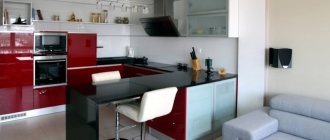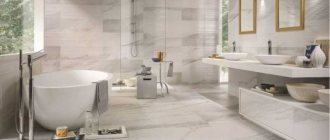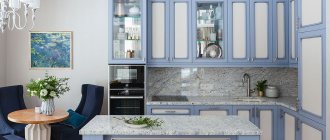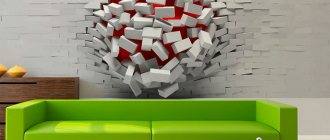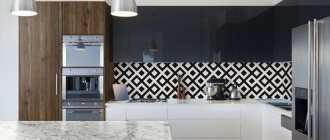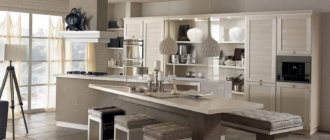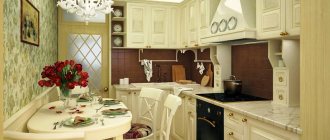Constructivism belongs to the group of avant-garde styles. At the end of the 19th and beginning of the 20th centuries, new movements began to emerge in the fine arts that completely rejected traditions. They clearly showed persistent attempts to find something new and previously unused. Avant-garde originates in Europe, where its main inspirers worked, and the USSR is considered the birthplace of constructivism. In the first stages of the formation of Soviet power, an “international” style began to be developed, which reflected the main aspects of collectivization: simplicity of forms, laconicism in decoration, strict geometric shapes. In part, constructivism resembled a potpourri of abstractionism and minimalism. Initially, the direction “leaked” into architecture. In those days, urban development accelerated, as the new government sought to create its own rational world on the ruins of the previous one. Then the style moved into landscape design, interior design and captured the cultural side of the life of Soviet people: literature, music and photography.
However, as we know, a movement cannot live “fully” within one country, and the ideas of Russian architects began to be adopted by their foreign colleagues. Thus, constructivism crossed the “closed” borders of the USSR and gave rise to new stylistic branches that followed their own paths of development. Before the outbreak of World War II, a sharp decline in the direction was artificially provoked. They forcibly began to change it to more pompous and luxurious options. The change in the country's leadership began to popularize completely different ideas, rejecting the previous ones. Constructivism in the interior will continue to be used, but there will be a degradation of the direction. Many architects and designers, being desperate adherents of this style, were unable to adapt to the “new rules” and chose to emigrate from the country. However, the history of the movement did not end there; constructivist ideas continue to live to this day. Rationalism, to which style strictly adheres, has again become popular after the next cyclical “turn” of fashion. Naturally, constructivists find original interior solutions that meet the new times and the needs of modern people.
Basic principles of design
Constructivism is most suitable for those who do not like excesses and who do not gravitate towards decoration. According to constructivist theorists, a chair is an object on which a person should sit. It does not have any other functions, so there is no need to use additional decorative elements to enhance the decorative effect of a utilitarian item. And so it is in everything.
Utilitarianism of the interior is the main motto of constructivism Source yandex.net
Finishing
When performing it, the simplest finishing materials are used. Straight lines, clean backgrounds, today the basis of design is concrete surfaces or painted plaster. When constructivism is recreated, it is important how smooth the walls are. You'll have to work hard to repair them.
Ideally smooth surfaces without relief are the main requirement of style Source yandex.net
At the beginning of the last century, in many projects one could see the use of glass blocks for the construction of interior partitions. Today this material is used extremely rarely. Modern constructivism is not as strict as its origins. Construction of niches and installation of lighting are allowed. But it is not part of the decor; its main function is additional lighting.
Interior based on direct Source samosoverhenstvovanie.ru
The low ceiling is simply whitewashed. In spacious rooms, a multi-level structure with regular geometric shapes can appear on the floors. Base color white or grey.
Geometry in everything, including ceiling decoration Source yandex.net
On the floor there is wood or tile, the color of which is a couple of shades darker than the sheer surfaces. Contrast works well. Then the walls and ceiling are painted the same color, and the bottom is made black.
Light top, dark bottom Source roomester.ru
See also: Catalog of companies that specialize in designing country houses.
You can often see podiums. They perform several tasks at once: they determine the boundaries of one functional area, provide convenient lifting to shelves on the wall, to a bed, the frame of which is located above the level of free space.
The podium is a striking feature of style Source zamolotkom.ru
Beautiful design of the recreation area Source arxip.com
Accents are best kept clean. The space remains open, but there is a clear division into functional zones. It is most often made with paints. The most favorite ones are blue, yellow, red.
Functional areas are designated using bright colors Source zamolotkom.ru
Furniture
If constructivism is chosen, the interior turns out to be very laconic, but multifunctional. The furnishings do not take up much space. Only the essentials are used. It should have a simple execution. Aesthetics fade into the background. The first is functionality. All pieces of furniture perform their function: chairs are comfortable for sitting, the sofa is moderately soft, and the cabinets are as spacious as possible.
Only functionality is in the foreground Source yandex.net
The absence of additional decor is welcome. The upholstery and color of the soft group is monotonous. The color scheme is discreet. The outlines are the simplest. The shape is strictly geometric. The sofas are large. They are formed from separate modules. Transformable chairs. If necessary, they can easily be converted into an extra bed.
Living room decorated in constructivist style Source decorateme.com
Decoration Materials
As they say, you won’t go broke on finishing materials for constructivism. The direction prefers “budget” options: glass, metal, plastic. Imitation of expensive materials is rarely used, since arrogance and attempts to reach the status of “luxury” are not about this practical style. Constructivism does not need to prove anything to anyone, because it is self-sufficient. However, the direction is not without a unique touch of elegance. It is embodied in chrome and glass surfaces that stand out against the background of plastic. The walls are covered with simple wallpaper, the ceiling is plastered and painted or whitewashed, and the floor is covered with laminate or parquet boards, devoid of traditional wood patterns. In more modern versions, self-leveling floors and suspended ceilings (plain and without patterns) are used. In textiles, preference is given to simple naturalness: cotton, linen, burlap. Rough textures with visible stitches of fibers are encouraged. It is important to know. Designers recommend abandoning the popular wood of brick and stone. These materials will look alien in the style of the room, as they will violate its basic principle: minimalism in decor and decoration.
Constructivist decoration of walls, floors and ceilings
The walls should be smooth, preferably simply painted, without any decorative finishing. You can decorate them with an abstract pattern using 2-3 colors. The design itself should be extremely simple: large rectangles, circles, a wide stripe.
You can put up wallpaper, but it should be plain, without a prominent texture.
The pattern of the walls should be repeated on the ceiling. For example, it could be a bright stripe that goes from the ceiling to the wall. The main color of the walls and ceiling is white. You can use suspended ceilings to create a smooth, even surface. If the ceilings are high, then you can use plasterboard to create a three-dimensional geometric structure.
USEFUL INFORMATION: Which wallpaper to choose for the kitchen?
Light or dark laminate is usually laid on the floor. It should be either almost white or close to black. Light tiles are used in the kitchen.
Furniture
Furniture is chosen according to the principle: the simpler the better. Each room has a sufficient functional minimum, which will be used for its intended purpose, and not stand “for beauty”. Constructivism also has its own concept of the latter. It is expressed in rationality, rigor and stylistic restraint. A kind of “adult” idea of beauty, contrasting with the “youthful” beauty of romanticism or the bright charm of Provence. In the furniture, as well as in the decoration, plastic prevails, which is offset by metal, glass and mirrors. The surfaces are smooth, without a relief texture. Upholstery of sofas and armchairs with a rough texture made from natural materials or their combination with synthetics.
The need for simple furniture, which was mass-produced in those days, arose from post-war shortages. In order for standard products to be produced quickly and cost a penny, we had to abandon all the frills. For this reason, furniture performed only basic functions: they cooked, ate, slept, sat, worked and rested on it. All other “delights” were the lot of the bourgeois layer, which was despised.
Selection of furniture and equipment
Furniture for its intended purpose is the main postulate when filling an interior in the constructivist style. The aesthetic side of furniture fades into the background, giving way to practicality and functionality. Chairs are for sitting, a table is for working or eating, a sofa is for relaxing, a closet is for storing clothes or dishes.
Functional and apparently simple furniture is a sign of the chosen design
Any decorative elements are unacceptable. The legs of furniture pieces are small, without pretentiousness, furniture shapes are preferably the simplest - circle, square, rectangle. When choosing furniture, you should not strive for uniqueness; this is completely irrelevant in constructivism. The amount of furniture in the room is minimal.
Only the essentials should be placed in a room of this design.
Even furniture coverings should serve a clearly defined purpose. For example, a sofa blanket is not used for decoration, but to warm the owners of the room.
The materials that designers use for furniture are wood, metal, leather, fabric, leatherette. Open designs of shelving, shelves, and cabinets are another noticeable aspect of furniture.
The latest technology fits perfectly into the constructivist style. It seems to be in tune with this design direction, so any room equipped with the latest household appliances will correspond to this style. The interior contains huge plasma TVs, home theaters, built-in washing machines and dishwashers, etc.
All equipment that meets modern requirements is built-in and practical
By loading the room with the achievements of technical progress, you can not only surprise your guests, but also be on the same wavelength with the chosen design.
Color solutions
The style is always based on a color “trio”. If you use more shades, the laconicism and harmony of the interior picture may be disrupted. Two colors, as a rule, are neutral in nature: white, gray, black, brown, and the third is chosen based on the principle of contrast. The latter tone plays in the details of furniture and decor. Particularly popular are:
- Red;
- Blue;
- Green;
- Yellow.
It is not recommended to use drawings, ornaments and patterns.
Style color palette
Color is one of the style tools used to decorate a room. The constructivist style in the interior uses bright colors in combination with black and white to achieve a contrast effect. Characteristic color combinations:
- White and black;
- white, black, red;
- white, gray, red;
- blue and white;
- yellow, white, black;
- yellow, red, white.
The main color is usually white, and the rest are used to highlight individual elements.
Lighting
Natural light has a special place in constructivism. There should be as much of it as possible so that the room literally bathes in it. In private houses, floor-to-ceiling windows are installed for these purposes. This nuance is taken into account at the design stage. In apartments where it is no longer possible to change the order of things, the windows are framed with plain curtains and airy tulle, which looks more like a light cobweb. Such a conditional “obstacle” will not prevent the sun’s rays from playing on metal and glass surfaces in the interior. Artificial lighting is worked on at three main levels. The overall look is usually decorated with a ceiling chandelier, which is located strictly above the center of the room. Additional lighting is provided by floor lamps and wall sconces, the shades of which have the simplest possible shapes. Local devices are installed in places for reading or working. Typically, table lamps are used as light sources.
In especially small rooms it is better to avoid curtains altogether. They are being replaced with practical blinds, so as not to bring with them the touch of an “office” environment, choose non-standard panel colors: deep blue, grass green, sunny yellow.
Living room
The living room is used for collective relaxation and receiving “visitors”. This room contains a wardrobe, a sofa, a couple of armchairs and a coffee table. The white floor is covered with a square beige rug, which conventionally marks the center of the room. They start from this point when creating an interior composition. A seating area is set up around the carpet: one corner sofa or two symmetrical ones opposite each other. There is a coffee table between them, and additional chairs nearby, in case of a large number of guests. The wall with the window is left open without furniture, so that nothing prevents light from entering the room. Opposite the seating area they hang a flat-screen TV that no longer needs stands. A cabinet with closed shelves is installed on the opposite wall.
Living room in constructivist style
The living room should have the necessary minimum furniture - a sofa, armchairs, a dressing table, a stand with a TV. All of them must have strict forms. You can use a contrast technique - combine a white sofa with bright yellow or red armchairs.
USEFUL INFORMATION: Getting involved with art: frescoes on the wall in the apartment
You can decorate the room with open shelves. It is allowed to lay a rectangular carpet with a geometric print on the floor.
Bedroom
A functional “set” for a bedroom includes a bed, bedside tables, a chest of drawers, a pair of chairs or poufs and possibly a wardrobe. The bed is chosen with a metal frame in black or white. It is covered with a light-colored bedspread: only two or three plain pillows are allowed as decor. Two bedside tables are placed symmetrically on the sides of the bed. Each one is equipped with a lamp with a simple, white shade. The floor in front of the bed is covered with a small square carpet or two small ones on either side of the bed. The cabinet can be replaced with a combined type design with open and closed shelves. This exceptional step is allowed only to dilute the atmosphere of the rest room. Books or meager souvenirs, made in the best traditions of minimalism, are placed in open shelves.
Wall-mounted structures (bedside tables, beds) look original in the interior, embodying practicality in its highest form.
History of appearance. Constructivism as an aesthetics of expediency
Constructivism in the interior is an avant-garde movement that originated at the beginning of the 20th century in the Soviet Union. This style arose out of the need for practicality and convenience, becoming a reflection of the new political and economic situation. This style is based on rigor, geometricism, conciseness, completeness, solidity, as well as rationality in the management of space and household items, the absence of unnecessary details.
This term appeared in 1922 thanks to A.M. Ganu, who wrote the book “Constructivism”. Constructivism arose as a response to Art Nouveau - with its rich decor and pretentiousness. The predecessor of constructivism was the avant-garde style.
In the 20-30s of the last century, there was a desire for modern finishing materials, and priority was given to an interior that was as convenient as possible for comfortable human life. Over time, this style acquired aesthetics. At first, constructivism was viewed with skepticism and was called boring, but over time it became a widespread trend in interior design. Constructivism gained popularity both in the USSR and in the West.
Kitchen
In the kitchen, preference is given to a set rather than separately purchased items. Its surface can be either matte or glossy, and this is where the “right” to an accent color is exercised. The set can be red, blue, yellow. The more active the shade, the less it is used additionally in decorative items. The kitchen apron is decorated with ceramic tiles without patterns in simple colors. It is permissible to create a “chess” composition. The floor is also tiled to match the apron, but larger in size. A square table is not decorated with a tablecloth, and chairs are chosen with hard seats without upholstery. Windows are traditionally only lightly curtained.
Children's
Constructivism is rarely used to decorate a children's room. A child may find such a room too boring, but the style also has its advantages. Taking into account children's needs, growing every year, the character of a baby in practical conditions can be formed according to a completely different model. Naturally, there will be more bright accents in the room than in other rooms. As an exception, the presence of a pattern is allowed: geometric shapes and their combinations. The entire minimum furniture fits in one corner: a “loft” bed with a storage area and a workplace.
What is remarkable about constructivism in the interior?
Relatives of this trend are high-tech, minimalism, eco-tech. But constructivism has unique features that distinguish it from all other styles.
- Designers focus on the geometric shapes of furniture and decorative elements.
- Every item in the interior has a practical purpose.
- Constructivism does not accept elaborate patterns.
- The walls and floors are finished with simple materials, without any pretense of luxury.
- Large rooms are divided into small zones, each of which has its own function.
Bathroom
Wall-hung toilets and overhead sinks are actively used in the bathroom. An abundance of mirrors, glass and metal will be a stylish addition to the decor. It is better to replace the bath with a practical shower stall. The corner where it will be located can be finished with ceramic tiles of a different color from the rest of the walls, but within the chosen tone composition. It is not recommended to place storage areas in small rooms. There are a number of non-standard options (narrow shelving, shelves under the ceiling) that constructivism simply will not accept. The lack of natural light will have to be compensated by increasing the number of artificial light sources.
Hallway
In the hallway there is a closet for storing things and shoes. Open shelves are excluded in it, since this will not comply with the rule of “systematization” during storage. The walls are covered with wallpaper: light in large hallways and dark in small ones. It is recommended to discard the chest of drawers as an unnecessary interior object. Instead, install a tall floor mirror with a simple frame (possibly in a bright color as an accent). If a chest of drawers is still present, then choose a wall-mounted model that will add original notes to the interior. A bench or two low stools for changing shoes are chosen in contrasting shades.

